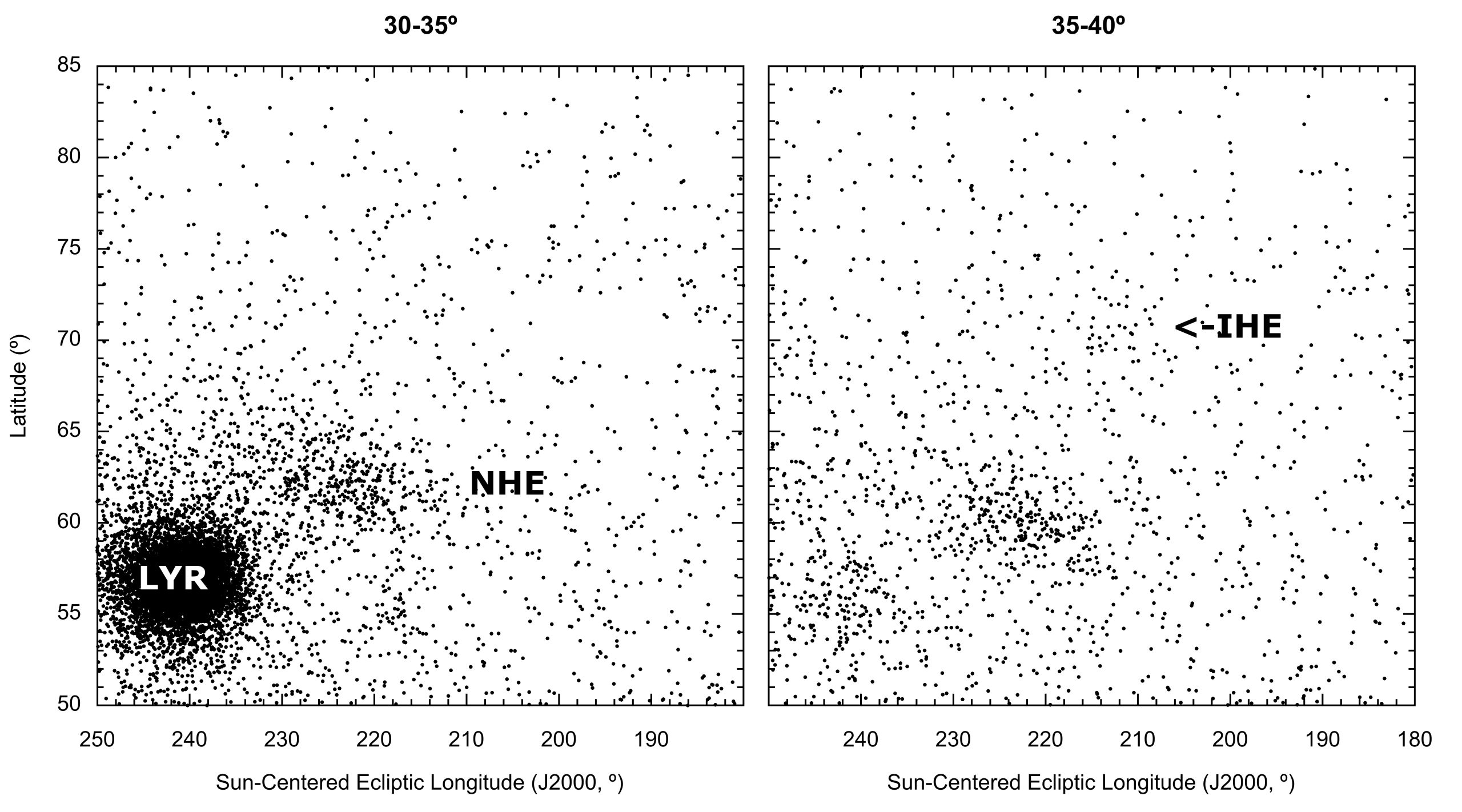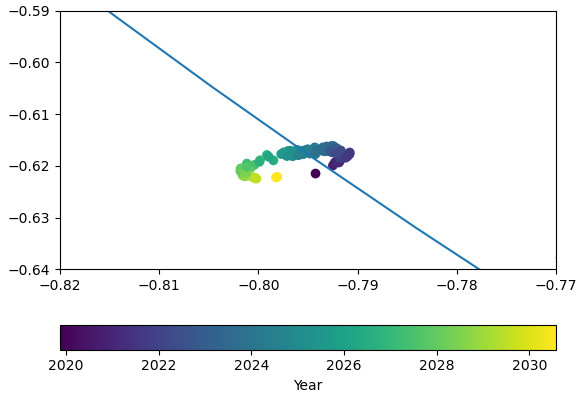By: Peter Jenniskens and Stu Pilorz
Abstract: The new April 27/28 shower in Hercules reported from GMN observations is found to have a weak associated annual shower in past CAMS data.
Introduction
Last week, Vida & Segon (2024) reported the detection by the Global Meteor Network of a brief meteor outburst from a shower in the constellation Hercules in the night of April 27/28, 2024. The shower was given the designation M2024-H1. The shower was not reported in the past and is therefore not included in the recent Atlas of Earth’s Meteor Showers (Jenniskens, 2023). The shower radiates from near the 4th magnitude star iota-Herculis, therefore a suitable provisional name is iota-Herculids (IHE). The shower only lasted about 4 hours, with activity between solar longitudes 37.70 and 37.85 degrees narrowly concentrated around 37.80 degrees.

Figure 1 – The plot of the radiants obtained by the CAMS networks during 2010–2024 for the solar longitude interval 30-35º (left) and 35-40º (right). The weak iota-Herculids are marked in the right diagram. Other showers in this region are the April Lyrids (LYR) and nu-Herculids (NHE).
Observations
The 2024 outburst was not detected by the global CAMS networks because of overcast conditions in the BeNeLux and in Turkey. We examined the past CAMS observations and found that there is a weak annual shower at this position in ecliptic longitude and latitude that stands out by having slightly higher velocities than the nearby sporadic background. In total, 33 shower members were identified over the solar longitude interval 35.7 to 39.1 degrees. The number of detected shower members for each year since 2011 was: 0, 0, 0, 1, 1, 0, 1, 2, 4, 5, 9, 4, 6, 0. Some of the gradual increase in numbers is on account of more cameras participating in the network, with the more recent years showing activity anually. The median orbital elements (with 1-sigma dispersions uncorrected for observational uncertainty) are listed in Table 1.
Table 1 – The median orbital elements (Equinox J2000.0) compared to the 2024 outburst orbit from Vida & Segon (2024).
| IHE outburst
GMN: 2024 |
IHE annual shower
CAMS:2014-2023 |
|
| λʘ (°) | 37.80 | 37.8 +/- 0.8 |
| αg (°) | 261.1 | 260.9 +/- 1.7 |
| δg (°) | +47.3 | +48.2 +/- 1.3 |
| vg (km/s) | 35.6 | 35.4 +/- 2.1 |
| λ – λʘ (°) | 214.24 | 212.9 +/- 3.1 |
| β (°) | +70.15 | +70.8 +/- 1.4 |
| a (AU) | 29.8 | 18.0 |
| q (AU) | 0.953+/- 0.005 | 0.956 +/- 0.009 |
| e | 0.968 +/- 0.068 | 0.947 +/- 0.136 |
| ω (°) | 206.97 +/- 1.55 | 206.4 +/- 2.4 |
| Ω (°) | 37.819 +/- 0.025 | 37.8 +/- 0.8 |
| i (°) | 55.77 +/- 1.02 | 55.2 +/- 2.2 |
| Π (°) | 244.79 +/- 1.58 | 244.0 +/- 2.5 |
| Tj | 0.85 | 0.97 |
| N | 25 | 33 |
Discussion
The annual shower was also detected by the SonotaCo network, with 6 meteors radiating from this direction and with this speed spread over the years 2007 (2), 2012 (1), 2013 (1), 2017 (1) and 2019 (1), all from the nights April 26-28.
The source of the shower was identified as a Halley-type shower by Vida & Segon (2024) based on the measured orbital elements. Indeed, the Tisserand parameter is in the range of Mellish-type comet showers (Jenniskens, 2023). However, the fact that the velocity of meteors is slightly higher on average than the sporadic background before and after the shower suggests that the meteors move in a long-period comet orbit. A Halley-type comet might be expected to have a more intense associated annual shower if it is trapped or librates about a mean-motion resonance. If due to the 1-revolution dust trail of a prograde long-period comet, the sighting in 2024 makes it possible to predict when the next iota-Herculids outburst is expected (Lyytinen & Jenniskens 2003).

Figure 2 – The motion of the iota-Herculids dust trail relative to Earth’s orbit between 2020 and 2030.
Figure 2 shows the calculated motion of the dust trail relative to Earth’s orbit, starting from the orbit for the outburst iota-Herculids in Table 1, assuming that this orbit describes the center of the dust trail. Adjusting the orbital period to that of a typical long-period comet, between 250 y (e = 0.976) and 4000 y (e = 0.996) (Jenniskens et al., 2021), results in a similar pattern. Coordinates are in units of AU and the color scale is in decimal years. From this, it appears that the dust trail was close to Earth’s orbit previously in late 2020 (but not in April that year) and will not return until the early 2030’s. The first likely return will be on 2033 April 28 at around 00h21m UTC (solar longitude 37.584º, J2000).
References
Jenniskens P., et al. (2021). ” Meteor showers from long-period comets.” Icarus 365, article id.114469.
Jenniskens P. (2023). “Atlas of Earth’s Meteor Showers.” Elsevier, USA. 838 pp.
Lyytinen E., Jenniskens P. (2003). “Meteor outbursts from long-period comet dust trails.” Icarus 162, 443–452.
Vida D., Segon D. (2024). “New Shower in Hercules.” eMeteorNews (posted on May 1, 2024).






